How Much More Does Crossing The Holland Tunnel Cost Today?
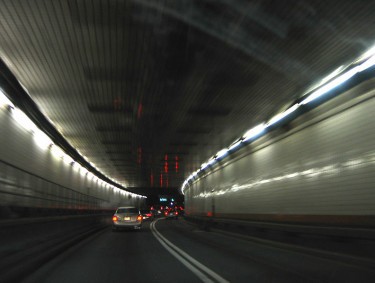
You do not need the ghost of Andy Rooney to remind you that, if traveling by automobile is a big chocolate cake of frustration, then the tolls that may be collected from you are the frosting. These tolls are such an annoyance (if not an outright burden) that they’re avoided as a topic by even the most amateur of our stand-up comics. And of the costs that are difficult to avoid in the day-to-day, these are definitely increasing, right? Increases mount, and what was once an afterthought, tossing some change into a basket, is now an expense to be reckoned with.
But even if we all agree that, yes, nationwide, tolls are skyrocketing, does this necessarily mean that these tolls are actually more than what’s been charged on an historical basis, when the old tolls are adjusted into modern dollars? In other words, are toll increases actually increases, or just adjustments keeping up with inflation? With apologies to you city dwellers (like me!) who judge this to be a topic that could easily be obviated by taking public transportation, let’s see what transportation tolls have done, and, to narrow the focus, let’s look specifically at the Holland Tunnel.
***
Why the Holland Tunnel? Well, for one, it’s the first of its kind. Connecting Jersey City with Lower Manhattan, the Holland Tunnel runs about a mile and a half underneath the Hudson River, and carries around twenty million vehicles a year in each direction. And it’s not just a daily commute boondoggle — it’s also an historic feat of engineering, recognized by the U.S. Department of the Interior as a National Historic Landmark and by the American Society of Civil and Mechanical Engineers as a National Historic Civil and Mechanical Engineering landmarks — honors that are not handed out like Rite Aid circulars.
A hundred years ago, the men responsible for the civic planning of the greater New York metropolitan area were coming to realize that some of the features that made the location a good one for a large city were also prohibitive for growth. New York City is located where the Hudson dumps out into the Atlantic Ocean — extraordinarily useful for placing a city, as water was historically advantageous for trade. But the city is not just a good place for ports, it’s an archipelago, with only two out of five boroughs contiguous. So even as trade flowed in, all that water made getting around, between the boroughs somewhat of a hassle, especially as population grew and more and more goods and people needed to cross the rivers. At the time, none of the Hudson bridges or tunnels existed, so crossing was accomplished primarily by ferries, and was aided by two railway tunnels that were built (in 1908 and 1909) under the Hudson. Add in newly created vehicular traffic, as people began to purchase the new-fangled horseless carriages, and it was obvious to those involved that the Hudson needed to be forded.
Civic planning on this scale is never easy. In this case, two different states were involved, and New York and New Jersey each formed commissions to be headed by engineers to come up with a solution. They settled on a tunnel as the first effort, and selected the straits between Jersey City and Canal Street due to the presence of railyards on the one side and a warehouse district on the other. There was of course all manners of political and parochial bickering between the states, patronage scandals, power grabs and kickback schemes (some things never change), but construction began in 1920, with the states splitting the expense. (For more detail on colorful political obstacles surmounted, go grab Highway Under The Hudson: A History of the Holland Tunnel by Robert W. Jackson, which is exactly what its title says.)
How does one build a tunnel underwater? That’s certainly a question that vexed me as a little kid. In the case of the Holland Tunnel, they started on either shore, sunk a big hole and then bored through the earth by pushing what they called a shield, which was the size of the circumference of the tunnel, inch by inch forward. After each incremental progress, the dirt and muck would be carted out, and a cast-iron sheath would be bolted into place behind the shield. So if anyone asks, yes, the Holland Tunnel is made of cast iron.
It was (as it would seem) a difficult operation. Although other underwater tunnels had already been built, leaving an available population of engineers and laborers with experience at this, it was still a dangerous occupation, as the sandhogs were working in chambers pressurized with compressed air to keep seeping water out. This is where the bends became understood, and not through deep sea diving, as workers who returned to normal air pressure conditions too quickly would come down with depressurization sickness — nitrogen bubbles in the bloodstream that cause various sorts of pains and discomforts, up to and including death. Thirteen sandhogs lost their lives in the building of the tunnel (and those are just the deaths that were reported).
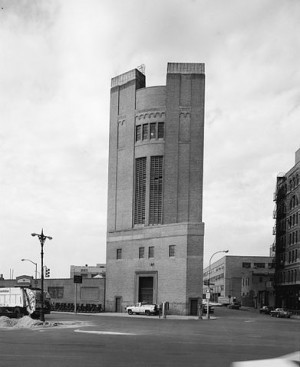
The tunnel also took the life of the man who conquered the biggest problem facing the tunnel. His name was Clifford M. Holland, and he was the engineer selected to oversee the entire project, mostly for his experience in overseeing subaqueous subway tunnels under the East River. But while subway and train tunnels carried traffic that was powered electrically or by steam engines, cars are powered by internal combustion engines, which manufactures the by-product of carbon dioxide as exhaust, which is lethal in enclosed spaces (like garages, or global climates). They could build a tunnel under water, but they had to figure out how to dissipate the noxious fumes, lest the tunnel becomes one big suicide machine.
Holland solved it with ventilation. The tunnels (there are two of them, one in each direction) are circular, but the roadway and the ceiling are flat. The empty spaces under the roadway and above the roof are basically giant ventilation ducts, one pushing in fresh air and the other sucking out bad. On each shore of the river, there is a giant building (each with an Art Deco façade, so easy on the eyes) which is the power plant for the ventilation. Turns out it worked, although Holland didn’t make it to see, as he succumbed to the pressure of the project and poor health in 1924. But they did name the tunnel after him, so, no, the name of the Holland Tunnel is not a nod to the Dutch that first settled the area, but rather a posthumous honor bestowed, if not a nearly-anonymous one. As Ian Frazier wrote in a New Yorker essay in 1990 (sub. required), “At the time the tunnel was named for him, editorial writers worried that people would think that the name had something to do with Holland the country. In later years, that happened.” (Going off in search of people who can tell him how the tunnel got its name, Frazier eventually gets a correct answer: From a tourist from Japan.)
In 1927, the Holland Tunnel opened, an occasion that was somewhat of a holiday for New Yorkers (and the New Yorkers living in Jersey), with speeches and parades and fireworks. And on the first day of operation, over fifty thousand vehicles drove the tunnel, each paying fifty cents for the honor (which, by the way, converts into $6.46 in 2011 dollars).
***
In case you have never traversed the Hudson River via the Holland Tunnel, here’s a brief description. There are two tubes, with two lanes in each tube. Ten years or so ago they painted LANE IN STAY at beginning of each tube, as there is no passing. A narrow walkway runs down the length of the right side, but there’s nothing in the way of a break-down lane. The walls and roof are tiled, like a public bathroom wall, and here and there are patches where the tiles have fallen and not yet been replaced. The tiles are differing shades of beige, as if the wallpaper of the sitting room of a fifty-year smoker. It’s like driving down a corridor in an office park somewhere, over an institutional stain-resistant carpet, lit by flickering fluorescents. Not that it’s unpleasant. The traffic can be unpleasant, of course, but YOU’RE DRIVING UNDERWATER, which is a bit of a mind-blower the first time. It is not without its charm, but it is showing its age.
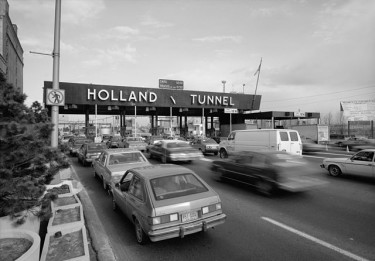
It’s apt that the Holland Tunnel is so unchanged in many ways, because, for nearly 50 years, the tolls were unchanged as well, at $.50 a pop. Technically, they increased to one dollar in 1970, but that’s a little misleading, as 1970 was when tolls were no longer charged in each direction. The Port Authority of New York and New Jersey, the agency tasked with operating and maintaining the Holland Tunnel since 1930 (and responsible for other Hudson River crossings, the PATH rail system, five area airports, bus terminals, the World Trade Center and the waterfront ports of the greater metro area), realized that by collecting tolls in only one direction, the costs of toll collection could be halved — and congestion eased in the non-toll collecting direction. So the toll went up to a buck, coming in from New Jersey, because you were basically (and still are) pre-paying for a round trip. The same thing happened with the Golden Gate Bridge in San Francisco in 1968, when the each-way toll of $.25 became a one-way toll of $.50.
Incidentally, toll hikes were never contemplated in the original plan to build the Holland Tunnel, as tolls were to be rescinded after the initial costs of building the tunnel were recouped. But by the time this recoupment was close, PANYNJ had taken over the tunnel, and needed further financing for the construction of all the other Hudson River Crossings named after engineers (Goethals, Outerbridge) or presidents (Lincoln, Washington). PANYNJ is entirely non-profit, as it runs according to an interstate compact negotiated between New York and New Jersey. For PANYNJ to raise capital, it issues bonds, approved by the two states, which are backed by PANYNJ’s toll and rental income. Long story short, when PANYNJ needs financing, they raise tolls.
Of course toll hikes are controversial events. Beyond the complaints of the nine-to-fivers and the red-faced op-eds, the American Automobile Association has a habit of taking PANYNJ to court over the hikes. The first time was in the late ’70s, after the first hike in decades in 1975, from $1 to $1.50 ($6.27 adjusted); the case, alleging that the increase was unreasonable under an old federal statute, as was a second suit in 1987, and a third over the most recent increase which took effect last year.
But by the ’80s and after, the increases come at a pretty steady clip, as listed below. Keep in mind that these are all cash tolls paid, without discount. The PANYNJ has diligently offered numerous mechanisms to alleviate the burden on daily commuters — discounted ticket books, high-occupancy vehicle discounts, off-peak pricing and the EZ-PASS transponders that are pretty much ubiquitous by now, which of course were and are taken advantage of by commuters, but for my purposes, we’re using peak, non-discounted, wait-in-the-long-line tolls, because for the first decades of the tunnel, that’s what everyone paid.
1975 -1980 $1.50
1980 -1987 $2
1987–1991 $3
1991–2001 $4
2001–2008 $6
2008–2011 $8
2011 — NOW $12
It may be hard to believe that PANYNJ is a nonprofit, given the millions of dollars of tolls collected in the Holland Tunnel alone. The administration of PANYNJ is frequently a topic of debate, as, while it has to spend a lot of money to keep the traffic moving, it’s also taking in a lot of money at the same time, and public administration of funds is something people have a hard time agreeing on. But give yourself some quiet time with the most recent available budget [.pdf], and you’ll see that the revenues from bridges, tunnels and terminals is a little less than a billion dollars, with an overall budget over seven billion.
The problems of how we get stuff from one place to another, whether that stuff is goods or produce or our own personal selves, and who pays for it, are enormous ones, and the surfaces of which are hardly being scratched in this piece. But the upkeep of PANYNJ’s massive network of infrastructure doesn’t pay for itself, any more than the building of it did. Without taking sides in any of the myriad chair-fights over infrastructure, if the Holland Tunnel tolls are a rip-off, they are rip-offs borne of necessity.
***
But are the Holland Tunnel tolls a rip-off, perceived or not? Let’s look.
Below is the price-adjusted list, in 2011 dollars. All tolls are for round-trips (so pre-1970 tolls are doubled), and without the discounts available at the time, and an arbitrary ten-year gap is applied to the fifty years in which the toll did not increase:
1927: $12.92
1937: $15.62
1947: $10.08
1957: $8.00
1967: $6.74
1975: $6.27
1980: $5.46
1987: $5.94
1991: $6.61
2001: $6.69
2008: $8.36
2011: $12
That is a trend that we’ve not seen before: a giant U. Holland Tunnel fares started out as pretty expensive, and then (other than a bump during the Depression), declined slowly, even after the toll increases began in the ’70s, and then started climbing back up to the high rates of the early days. It’s a pretty telling snapshot of the cost of infrastructure in the new century.
Compared to tolls at some of the other municipally run fee-based underwater tunnels in the U.S. ($4 each way for the Detroit-Windsor Tunnel, $3.50 one-way for the tunnels underneath Boston Harbor, $3 each way for the two tunnels underneath Baltimore Harbor), the Holland Tunnel does come off as comparatively expensive.
I’m confident that the job of running PANYNJ, or any of the other municipal authorities trying to keep bridges from falling and roads from disintegrating, is not a job that I’d volunteer for anytime soon. At the same time, even considering the hours I’ve spent in traffic and who-knows-how-much money I’ve spent on tolls, the absence of the Holland Tunnel, and the Hudson tunnels and bridges that followed it, is hard to imagine living without it. With this city, it seems about right that you have to pay to enter but anytime you want to leave it’s on the house.
Previously: Chinese Food, Books, Barbies, Televisions and Steak Dinners
Brent Cox is all over the Internet. Top photo by Kmf164; middle and bottom photos, both taken in 1985, courtesy of U.S. Library of Congress, via Wikimedia Commons.
Gucci Mane and Yo Gotti, "I'm In Love With A White Girl"
“The more positive attitude toward intermarriage represents a sharp break from the recent past and parallels behavioral change: about 15 percent of new marriages across the country in 2010 were between spouses of different races or ethnicities, more than double the share in 1980. The researchers presented the acceptance of interracial marriage as ‘the fading of a taboo.’”
— Good news for Gucci Mane and Yo Gotti! Good news for everybody, actually.
The Martin Amis Videogame Guide
“It’s a deeply strange artifact: an A4-sized, full color glossy affair, abundantly illustrated with captioned photographs, screen shots, and lavish illustrations of exploding space ships and lunar landscapes. It boasts a perfunctory introduction by Steven Spielberg (‘read this book and learn from young Martin’s horrific odyssey round the world’s arcades before you too become a video-junkie’), complete with full-page portrait of the Hollywood Boy Wonder leaning awkwardly against an arcade machine like some sort of geeky, high-waisted Fonz. We’re not even into the text proper, and already its cup runneth over with 100-proof WTF.”
— Mark O’Connell examines Invasion of the Space Invaders: An Addict’s Guide to Battle Tactics, Big Scores and the Best Machines, by Martin Amis.
Who Will Watch The Nazi Cats?
“A bizarre dispute has broken out in Germany over cats taken into custody that belong to an alleged member of a suspected neo-Nazi terror cell. An official at an animal shelter in the eastern state of Thuringia, says it may file a lawsuit against Germany’s Federal Office of Criminal Investigation (BKA), over who should pay for the upkeep of Beate Zschäpe’s cats. The felines are being cared for in a shelter in Zwickau, where Zschäpe lived until she blew up her home and turned herself in to police last November. Zschäpe is believed to be involved in a series of 10 murders over the last decade targeting people mainly of Turkish descent.”
Veggie Moussaka With Puy Lentils
by Ben Choi
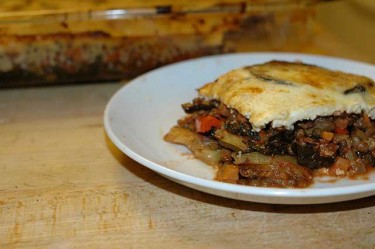
As we settle into the long, cold, dark days that come with the final slog through winter, we — your pals from The Awl and The Hairpin — will be bringing you some of our favorite casserole recipes (and crockery recommendations). But these won’t be just any old casseroles! No, no, that won’t do at all. These are fancy casseroles — or at least, not-gross ones.
Mama didn’t make casseroles. Because I grew up on (more or less) traditional Korean food, I’m not a native speaker when it comes to American culinary classics. Tamale pie and tuna casserole are ethnic foods to me. I was 19 when I first tasted mac ’n’ cheese, and I still think of Campbell’s Cream of Mushroom Soup as, well, soup. Since all the casseroles I’ve had were exotic dishes discovered in adulthood, they evoke in me technical curiosity rather than nostalgia. My casserole fairy godmothers are Alice Waters and Marcella Hazan, not Betty Crocker. As a result, I gravitate towards sophisticated, labor-intensive, tutti-foodie examples of the art. I am not a snob; I’m a foreigner.
I’m also a pretty serious carnivore. So when I was served an excellent lentil moussaka at a wedding a couple of years back, it was a game changer. I became obsessed with developing a satisfying, highbrow vegetarian potluck pick. This casserole incorporates the crowd-pleasing heartiness of lentils with the synergistic snob appeal of a deconstructed ratatouille like Thomas Keller’s. I was pretty spare with seasonings in this version, so feel free to embellish with your favorite herb or spice. This recipe is time-consuming; it might take you about three hours or more, so you might want to save it for the weekend. But on the plus side, it’s kind of a fun craft activity that can be split up and delegated to friends and family while watching The Godfather Parts I and II. It’s also a pretty good basic template for all kinds of assembled casseroles, like the seasonal vegetable medleys and gratins I’m sure your mama used to make.
Veggie Moussaka With Puy Lentils
1 large eggplant
2 or 3 medium zucchini
2 medium red peppers
1 large onion, 1/8-inch dice
2 cloves of garlic, minced
1/2 bunch of Tuscan kale
8 oz. Puy Lentils (the French kind that are speckled green and brown)
3 small carrots, 1/8-inch dice
2 stalks of celery, 1/8-inch dice
4 oz. feta cheese
1 28-ounce can of crushed tomatoes
a large pinch of oregano
3 bay leaves
5 or 6 basil leaves
1 tbsp. balsamic vinegar
1 tbsp. VSOP brandy or cognac
1 tbsp. goat cheese
1 1/4 cup of milk
2 tbsp. flour
2 tbsp. butter
1/4 tsp. grated nutmeg
1 beaten egg
1/4 cup of grated parmesan cheese
kosher salt
pepper
olive oil
1 quart water, and additional 1/4 cup
A lot of knife work to begin with. If you like, use a German knife and pretend you’re Angela Merkel bringing austerity to the Greeks. What you’re aiming for is big eggplant coins to line the bottom and top veggie layers and Trident gum-size pieces of zucchini and pepper, bite-sized but not so small as to be hard to flip with tongs.
Cut off the ends of the eggplant and use a peeler lengthwise to remove 3/4-inch strips in a zebra pattern. Slice crosswise into 1/8-inch rounds. This will take a very sharp knife or a mandoline. Take ends off zucchini and slice in half lengthwise. Now slice each of the halves lengthwise, into 1/8-inch thick planks, and slice the planks crosswise into three equal parts. You’ll end up with little planks about 1 3/4” long and 1/4” to 1/2” wide. Remove ribs from kale. Slice crosswise into ribbons.
Dice onions and separate into two roughly equal piles. Dice carrots and celery. Mince garlic. You should have a really full cutting board now.

Heat a large skillet (preferably cast iron) over high heat about a 3 tbsp. olive oil until glistening. In batches pan-fry the eggplant, zucchini and peppers, replenishing oil with each batch. Set completed batches on paper towels, season with salt an pepper. You want the eggplants to be rather soft and the zucchini and peppers on the firm side. Without adding any additional oil saute the kale for about a minute in residual oil. Shut off heat and add 1/4 cup of water to skillet and steam kale in resulting tumult. The water should almost entirely evaporate.
Now for the lentils. Heat 2 tsp. olive oil in a medium saucepan over medium-high heat. Add onions, carrots and celery, along with 2 bay leaves. Soften for about 7 minutes, stirring occasionally. Add lentils and saute with vegetables for about a minute, stirring. Stir in quart of water and bring to boil, partially covering saucepan with lid. Once a light boil is achieved, reduce heat to medium-low and simmer partially covered for about 15 minutes. You want the lentils al dente at this point, soft on the tooth but not a hint of mushiness. Turn off heat and let sit covered for at least a half-hour. Then salt and pepper to taste.
The tomato sauce that binds this dish should wind up looking about the same color as Chef Boyardee’s. In a saute pan over medium heat, add 1 tbsp. olive oil and the remaining onion. Saute for 5 minutes. Now add the garlic, bay leaf and the pinch of dried oregano stir and saute for about a minute. Add the can of crushed tomatoes, vinegar and basil leaves. Bring to a simmer.
Now remove the saucepan from the heat and run the hot mixture through a fine strainer, into a large bowl. Squeeze the pulp against the strainer with a spatula until mostly dry. Now scrape the puree along the outside of the strainer into the bowl. Dissolve the goat cheese into the still-hot sauce until you achieve a nice orangey hue. Blend in the brandy or cognac and 1 tsp. olive oil. Salt and pepper to taste.
We’re almost finished. Preheat the oven to 375 degrees. It’s time to assemble.
Layer bottom of Pyrex lasagna dish with half of the eggplant. Drizzle half the Boyardee sauce over the eggplant and spread evenly with a spatula. Arrange the zucchini and pepper in an evenly spread array. Drizzle with remaining sauce. Now strew the kale over that and add lentils with a slotted spoon and spread evenly. Pinch off blueberry-sized chunks of goat cheese over lentils and top off with remaining eggplant. Cover with foil and place into the hot oven. Set your timer to 25 minutes, and get to work on your egg and bechamel topping.
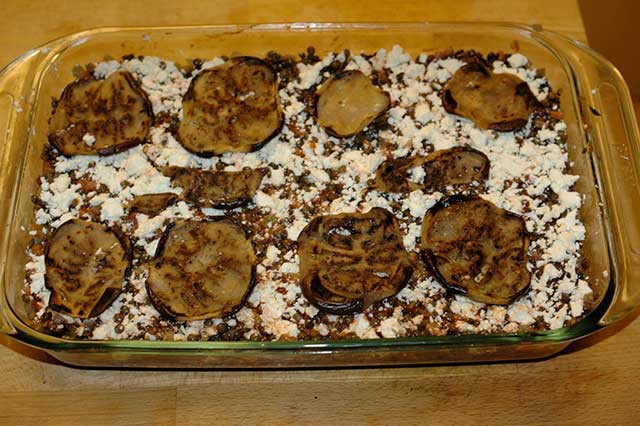
Over medium heat in a small saucepan begin melting butter. When butter is halfway melted, add flour and milk. Bring the mixture up to just below a boil, whisking constantly. The bechamel should be quite thick at this point, easily coating the back of a spoon. Turn off the heat and continue whisking for 30 seconds until even thicker. Remove from heat and blend in nutmeg. Let cool for 5 minutes and then whisk in beaten egg.
Finally, kneel in front of your oven, slide out the rack, remove foil and pour the white stuff on top and spread out with spatula. Sprinkle with parmesan, and continue baking for 30 additional minutes. Done. Finito!
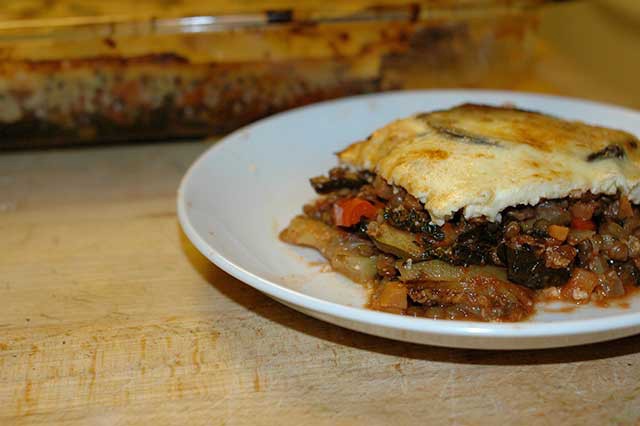
You know what, fuck the European Union! I don’t think the Greeks are lazy at all.
Previously: Chicken Mushroom Casserole for the Lazy Snob and Breakfast Hotdish, Minnesota Style
This site’s correspondent on condiments, Ben Choi lives in the SF Bay Area with his wife Erica and dog Spock. He’s considering a raw food diet.
Week Rough
Which day of the week is the most depressing and dangerous to your health? Let’s just go with “all of them.”
Spencer's Gifts Is Now A Health Food Store
Oh, Dave Berrgren of KARE, I feel your shame in having to end your report on the fact that people are eating Chia seeds with the line, “Experts suggest give Ch-Chia a ch-ch-try.” There’s no way a man can spit that out and still feel good about himself.
Poseur Goats Faking Accents To Impress New Pals
“Goats can develop their own unique accents accent from their surroundings, a British study has suggested. Researchers found the animals develop their own speaking voice when they move away from their siblings and mingle with others. They found that a goats’ ‘accent’ changed as they grew older and moved in different groups, disproving claims that their voices were entirely genetic.”
What They're Arguing About in El Paso
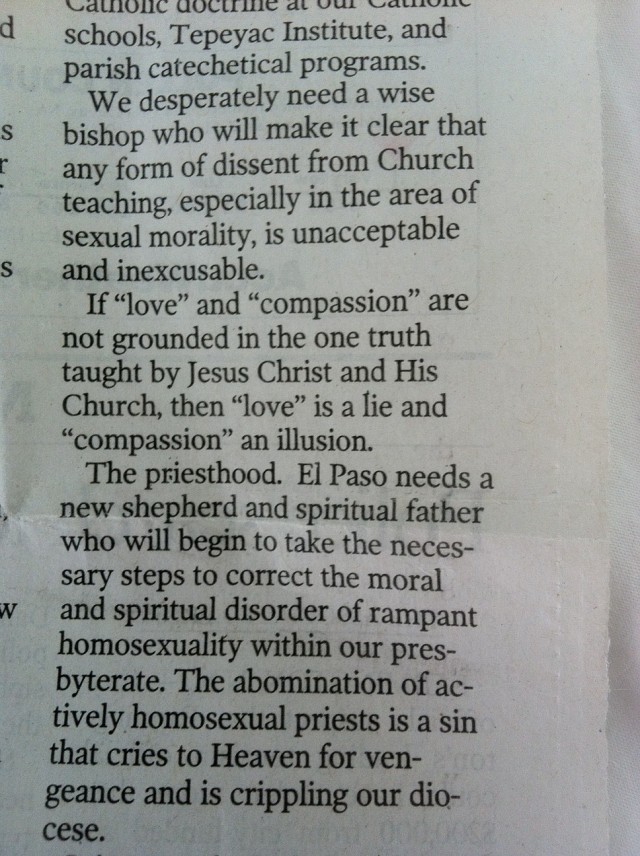
Atheist coastal elites miss all the fun. Did you miss this awesome op-ed in the El Paso Times? Perhaps you did; I know how it is, the paper comes from El Paso every day and it just piles up and who can get through it fast enough, right? Anyway, the bishop is suing this priest who wrote this op-ed, Michael Rodriguez — and also moved him out of town, because he’d become “involved” in efforts to recall the mayor, because the mayor supports health benefits for gay and unmarried partners of city employees. It’s big-time diocese drama! But yeah, probably not siding with the guy who thinks that the abomination of homosexual priests “cries to Heaven for vengeance.”
